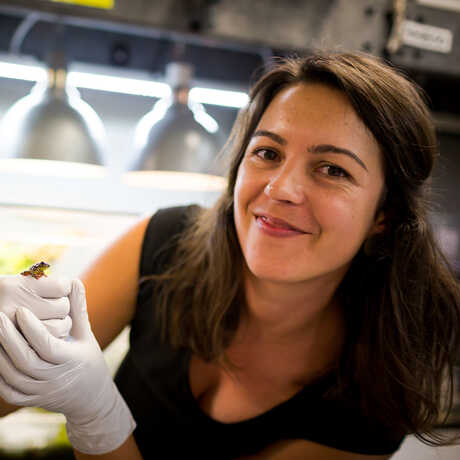Assistant Curator of Herpetology
I am an organismal evolutionary biologist who integrates genomic techniques with field biology to study diversification in amphibians and reptiles. Prior to joining the Academy’s Herpetology Department, I completed a PhD in Ecology & Evolutionary Biology at Cornell University, a Chancellor’s Postdoctoral Fellowship in the Museum of Vertebrate Zoology at UC Berkeley, and I served as Curator of Amphibians and Reptiles at the National Museum of Natural History, Smithsonian Institution.
The overarching goal of my research is to understand how evolutionary processes interact with organismal traits to generate diversity in natural populations. I first became interested in evolutionary research because I wanted to help conserve biodiversity for the future. To stay true to that goal, biodiversity discovery, science communication, and capacity building for research are core elements of my research program. My group’s current projects include a diversity of topics related to understanding ecological and evolutionary diversity in amphibians and reptiles. We address questions across multiple geographic and evolutionary time scales ranging from populations to species and higher-level systematics.
Project one: The evolution of visual systems during major life history transitions in frogs (in collaboration with Dr. Matt Fujita at the University of Texas Arlington, Dr. Jeff Streicher and Dr. David Gower at the Natural History Museum London, and an international team of frog vision experts and enthusiasts!). This project aims to characterize spectral, genetic, and morphological diversification of the visual system in relation to major ecological transitions in frogs. We received a U.S. National Science Foundation – U.K. Natural Environment Research Council award in January 2017 and have two talented postdocs on our team (Dr. Ryan Schott based at the National Museum of Natural History in Washington D.C. and Dr. Kate Thomas based at the Natural History Museum in London).
Publications coming soon!
Project two: The genomics of hybridization in São Tomé reed frogs (in collaboration with Dr. Stefan Prost and the Timp Lab at Johns Hopkins University). This ongoing project in the lab aims to integrate genomic, behavioral, ecological and morphological studies to characterize the roles of natural and sexual selection in structuring gene flow in the Hyperolius thomensis – H. molleri hybrid zone on São Tomé Island. Data collection to sequence draft genomes for this ongoing project is generously funded by a Smithsonian Institution Scholarly Studies Award.
Publications:
- Reed frog diversification in the Gulf of Guinea: Overseas dispersal, the progression rule, and in situ speciation
- Evolution of advertisement calls in an island radiation of African reed frogs
- Phenotypic and genetic divergence in reed frogs across a mosaic hybrid zone on São Tomé Island
Project three: Habitat conservation and adaptive strategies for recovery and conservation of Eleutherodactylus (coqui) frogs in Puerto Rico (in collaboration with Dr. Jaime Collazo at the U.S. Geological Survey North Carolina Cooperative Fish and Wildlife Research Unit, Dr. Adam Terando and Dr. Mitchell Eaton at the U.S. Geological Survey Southeast Climate Adaptation Science Center, Dr. Alberto Puente Rolón at the University of Puerto Rico - Mayaguez, and Dr. Eloy Martínez at Eastern Illinois University). This multi-disciplinary project aims to gain foundational knowledge to develop a well-informed adaptive conservation strategy to prevent Eleutherodactylus frogs endemic to the island of Puerto Rico from becoming “threatened” or “endangered”. The Bell Lab is leading the conservation genomics aims of this U.S. Fish and Wildlife Service and Climate Adaptation Science Center funded project.
